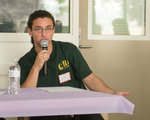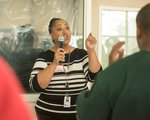



Under the best circumstances, being a teenager is no easy thing.
In September 2017, eight youths incarcerated on offenses as juveniles gathered at Green Hill School to tell stories about their far-from-ideal childhoods.
They’d been hooked on drugs, committed and been victims of violent offenses and have seen loved ones die due to gang violence or drug overdoses — all before most would have graduated from high school.
“I ain’t really been able to be a teenager,” said Shamar Slaughter, a Green Hill inmate who said he had his first run-in with the law at just 10 years old. He said kids on the street don’t realize real life in a gang isn’t like what you see in a music video.
“It’s not what it looks like on TV,” he said. “I got shot when I was 13.”
While many of them face long stretches in prison when they age out of the juvenile system, the youths who spoke at the event have all committed to working to make a better juvenile criminal justice system for the next generation.
“Our mistakes do not define us, and will not define who we are today,” said Aaron Toleafoa, a Green Hill inmate.
The youths from Green Hill School in Chehalis, Naselle Youth Camp and Echo Glen Children’s Home are all on the Washington State Partnership Council on Juvenile Justice Youth Committee, which meets regularly using an online video chat platform.
They gathered at Green Hill and spoke to a room full of attorneys, law-enforcement officers, judges and social workers as part of the Pursuit for Change program, which they initiated.
“I thought that was a great idea, and we ran with it,” said Steve Primas, compliance program coordinator for the Office of Juvenile Justice. “If we’re talking about juvenile justice, we need the experts at the table.’” You don’t know the generations to come that you are touching right now.”
The program took place at Green Hill School and was attended by dozens of stakeholders in youth criminal justice programs.
“We feel extremely blessed to be able to host such an important youth-driven event,” said acting Green Hill Superintendent Jennifer Redman.
The event also included a barbecue lunch and tours of the facility.
“This was eye-opening,” said Lewis County Jail Chief Chris Sweet, who attended the event with Undersheriff Wes Rethwill. “The big takeaway for me is just listening to them and listening to what they have to say to us.”
Each of the youths who spoke had a unique story, but many shared similar experiences.
Most of them started using drugs as teens, were expelled from school, had troubled home lives and had close family members also serving time.
Jacob Carmickle, 20, first smoked marijuana at 10 years old, encouraged by an older relative.
“All the pain just got buried away,” he said.
He was incarcerated at 16. He didn’t elaborate on the crime for which he was convicted.
Aaron Toleafoa recounted watching his older brother get arrested on a murder charge.
“My brother has 38 years and, unfortunately, I followed in his footsteps,” he said.
Kenan Adams-Kenard, 20, spent two years in a juvenile facility in a cell 23 hours out of every day before coming to Green Hill.
He said 14 of his family members have died while he has been incarcerated, most recently his stepmother, who he said overdosed on heroin.
“I had to realize I was my biggest enemy,” he said.
They spoke about healing from the traumatic experiences of their youth, with many referring to it as a long process.
“It’s like a wound getting covered up by a scab and then a scar,” Slaughter said.
The youth committee members were encouraged to tell their stories, but they also gathered to advocate for change or give feedback on the efficacy of juvenile justice programs.
When asked what they would change about the criminal justice system, they all agreed — stop auto-declining offenders to superior court.
When a youth between 16 and 18 is charged with a class A felony in Washington, the case is automatically tried in adult court. Children younger than 16 can also be tried as adults if the court can prove they thought like an adult would during the commission of the crime.
The members of the youth committee spoke out against that as well, saying evidence shows the brain is not fully developed until 25.
Nathon Brooks was tried as an adult for a crime committed when he was 13 years old.
“I made a lot of stupid mistakes,” he said.
But he didn’t know until he was incarcerated that he had a mental health condition — extreme depressive disorder — which he said likely affected him from early childhood.
“There was no way I could possibly comprehend this,” he said.
He faced a 50-year sentence, but was later able to take a plea deal for a minimum of 15 years in prison.
As another part of the Pursuit for Change program, students on the council wrote about their experiences in the juvenile justice system.
A packet with all of their stories, which Redman called “extremely personal” and “very touching,” was handed out to all attendees.
“I read it over and over again,” she said. “Hopefully it provides you some additional perspective on where they came from and how they ended up here.”
The students told attendees that while they can’t erase the past, their criminal convictions or their sentences, they can try to effect positive change for those coming into the juvenile justice system after them.
“How have we been doing this all these years and we haven’t had that voice at the table?” said Marybeth Queral, the superintendent at Green Hill for more than nine years, and now the assistant secretary for the Department of Social and Health Services’ Rehabilitation Administration.
“You guys can make such a difference in juvenile justice,” she said. “The more your voice is heard, the better we will do.”
Several leaders in youth justice programs encouraged the students to keep moving forward with their project.
“Don’t stop dreaming,” said Vazaskia Crockrell, director of the Office of Juvenile Justice and Equity. “When you stop dreaming you stop living.”